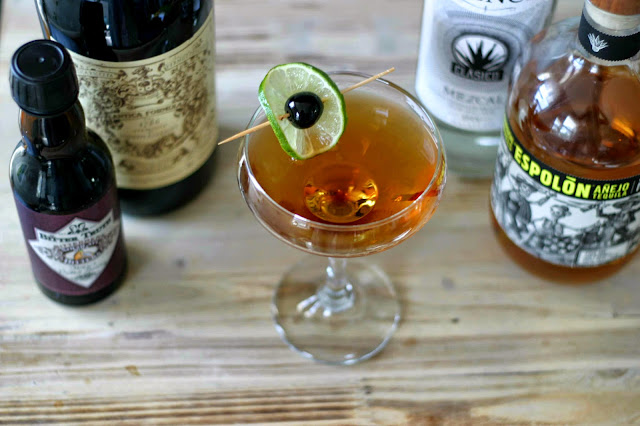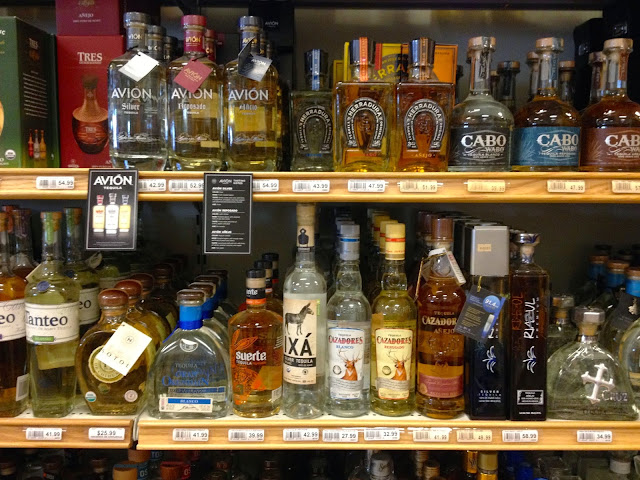When I first started drinking, I loved the really sweet stuff. The first things I bought for my bar were Midori, Malibu, and Peach Schnapps. Now the thought of making any of those things the main ingredient in a cocktail makes me nauseous. I guess it's a natural progression.
But that's not to say that sweet, tropical drinks don't have a place in an "adult" cocktail repertoire. Some, like the Mai Tai and the Daiquiri and the Singapore Sling, are still considered respectable when made correctly. Tiki bars seem to be experiencing a small resurgence in our current retro-obsessed craft-cocktail movement (most recently, I went to Beachbum Berry's Latitude 29 in New Orleans and want to go back and try every single thing on the menu). And finally, there are the drinks that are just too good to give up on. The ones that might be meant for sitting beachside but are honestly just as good if you're on your couch. The ones you want to drink in large quantities following a breakup (because whiskey would just be too much of a downer).
The Pina Colada is one such drink.
Say whatever you will about it. I love Pina Coladas (but not
getting caught in the rain, that kinda sucks). And there is no way I was going to leave it off of my list of cocktails just because it's a little frou-frou. No. I insist that the Pina Colada is a perfectly respectable cocktail. And I'm going to keep making them. So there.
History: The Pina Colada was (probably) invented in Puerto Rico in the 1950's or 60's. I say probably because there is a popular legend that it came about long before this, and - like any really good legend - it involves pirates. Specifically,
El Pirata Colfresi, Roberto Colfresi. He turned to piracy after his wealthy Puerto Rican family went bankrupt. After the death of Jean Lafitte in 1823, he became the biggest pirate threat in the Caribbean. Legend says that he would give his men a mixture of coconut, pineapple, and rum to improve morale. And thus the Pina Colada was born. Unfortunately, it died with Colfresi as well, when he was executed in 1825.
Much as I love the image of a grisly pirate sipping on a refreshing Pina Colada with a little umbrella in the cup, there isn't really much to back up this story. And even if was true, the recipe was lost. But if you'd like to cling to this bit of Puerto Rican folklore, perhaps it isn't so much who invented the Pina Colada in the 1950's as who rediscovered it.
There are three contenders. First, we have Ramon "Monchito" Marrero Perez, a bartender at the Beachcomber Bar in the Caribe Hilton of San Juan. He is credited with introducing the new drink in either 1952 or 1954. A fellow named Jose L. Diaz de Villegas, supposedly a friend of Monchito's, recently co-authored a book on Puerto Rican cuisine,
Puerto Rico: La Gran Cocina del Caribe (in English
here). He provides what he considers to be the original recipe. I haven't gotten my hands on a copy of the book yet to confirm that he really does claim to have known Monchito.
Others claim it was not Monchito at all who introduced the Pina Colada at the Caribe Hilton, but a Spanish bartender named Ricardo Garcia. The story goes that he was unable to make the bar's signature drink, the Coco Loco, because the coconut plantation workers had gone on strike. (The bar usually hollowed out a coconut to serve the drink in.) So the resourceful Garcia hollowed out pineapples instead, added some pineapple juice to the mix, and invented the Pina Colada.
Finally, the Barrachina Bar in San Juan also claims credit for the cocktail. Their bartender Ramon Portas Mingot may have invented it in 1963. That's an awfully big time gap for something as delicious as the Pina Colada to stay out of the historical record, but who knows. Maybe everybody was too drunk to write anything down about it.
One thing ties all of the disparate origins of the Pina Colada together: Coco Lopez cream of coconut. This mixture of coconut cream and sugar was created in Puerto Rico in 1948 by Don Ramon Lopez-Irizarry, a scientist and entrepreneur who developed a more effective way to remove the cream from coconuts. Coco Lopez became hugely popular, and the Pina Colada might never have come about without it.
So. If I want to make a Pina Colada, what recipe do I use? There are a ton of variations out there. Most stick to the usual rum/pineapple juice/coconut cream formula, but none seem to have the same proportions. Some, including the "original" recipe on the Caribe Hilton's website, also add cream. Some use white rum, some golden rum.
What's a girl to do but try them all? You know... for science.
One last note: A few sources say that the original at the Caribe Hilton was shaken, but otherwise a blender is always involved. Unlike the Margarita or the Daiquiri, which pre-date blenders, the Pina Colada was invented well after they came around, so it seems they were meant to be blended.
2 oz. white rum
1 oz. coconut cream
1 oz. heavy cream
6 oz. pineapple juice
1/2 cup crushed ice
The heavy cream in this one gave it an extremely creamy texture. If I let it sit for more than a couple of moments, it would separate and the cream would collect on top. Flavor-wise, it's missing something. The cream muffles the taste of the other ingredients. Plus, it makes an already bad-for-you drink into a true calorie bomb. Not worth it, in my opinion.
1 1/2 oz. rum (type not specified, so I went half and half)
3 oz. coconut cream
6 oz. pineapple juice
crushed ice (no amount specified, so I used about 3/4 cup)
Yum. This is my winner. It's the perfect combination of ingredients. I taste the rum, but it's not overpowering. It's the perfect ratio of coconut to pineapple, and the flavor is big and central. Love it.
2 1/2 oz. golden rum
1 oz. coconut cream
3 oz. pineapple juice
1 cup crushed ice or 5-6 ice cubes
Notably higher in alcohol content than the others, this one tasted too boozy. I have no objection to strong drinks if they're well-balanced, but I really want to taste the pineapple and coconut in this one. I think the ice contributed to it as well. If it sat for a while, it got watered down. It also separated as quickly as the Caribe Hilton recipe.
1 1/2 oz. light or gold rum (I used half and half)
2 oz. coconut cream
2 oz. pineapple juice
Ice (no amount specified; I used 3/4 cup)
This one is also good, especially if you like a higher ratio of coconut to pineapple. For me, it was just a bit too sweet and coconuty. I'd happily drink it if you gave me one, but when I compare it to the recipe by Diaz de Villegas, it lacks the nice tang of pineapple. Just a note: I had to increase the recipe by 50% to reach the volume of the others.
So here is the winner. You're welcome.
1 1/2 oz. white or golden rum (or half and half)
3 oz. coconut cream
6 oz. pineapple juice
~3/4 cup ice
Combine ingredients in a blender and blend until smooth. Garnish with a slice of pineapple and a cherry. Don't be ashamed - it's delicious.
Recipe from Wikipedia, probably taken from Puerto Rico: La Gran Cocina del Caribe.






























